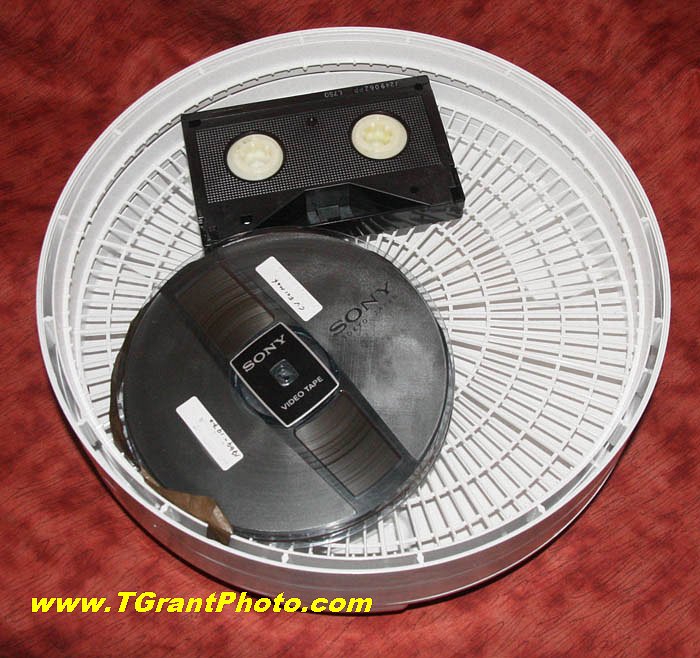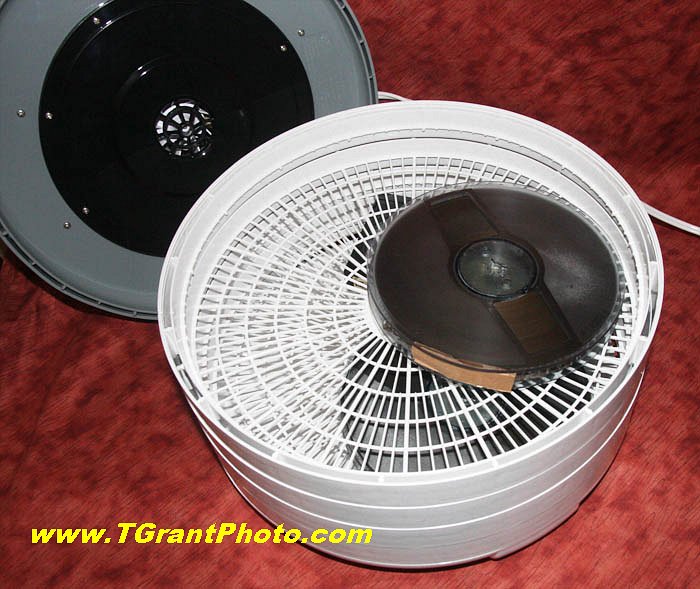Panasonic AG1980 $200 OFF plus Free Shipping
Limited to stock on hand. Look for "SALE" tag on lots of our items! Offer ends Dec.1st at midnight
Due to heavy volume, orders placed today ship out in 7 business days.
Baking Tapes
Do-It-Yourself Videotape Baking
Disclaimer: All the information on this website is published in good faith and for general information purpose only. TGrant Photo LLC does not make any warranties about the completeness, reliability and accuracy of this information. Any action you take upon the information you find on this website (www.tgrantphoto.com), is strictly at your own risk TGrant Photo LLC will not be liable for any losses and/or damages in connection with the use of our website.
This article is copyright TGrant Photo LLC. Copying or use on another website is prohibited.
Dealing with 'sticky-shed tape syndrome' has been one of our ongoing concerns. We receive weekly calls from VCR owners with clogged video decks caused by sticky tapes. When tapes have been stored for many years in an environment with humidity above 45%, the binder on the tape releases, causing 'sticky-shed syndrome'. This causes tapes to stick to the VCR's transport path. VCRs suddenly slow down during playback, video heads clog, and the whole tape path gets gummed up.
An extremely informative article written by Eddie Ciletti 1 put us on the right track. He outlines how baking tapes can restore their usefulness for a few weeks. This gives you a reasonable window of time to transfer your tapes to digital.
Most videotapes can be successfully baked. However do not bake acetate tapes2
TGrant Photo LLC stocks a customized tape dehydrator. It comes with specially sized trays that accomodate 1/2" tape sizes that are used by videophiles. The installed digital thermometer probe allows you to monitor the inside temperature while your tapes bake.![ULTRA-PRO Videotape Baking Dehydrator w. built-in digital temp probe [TGP863]](https://www.tgrantphoto.com/sales/sc_images/products/20210323_160652-sca1-1000.jpg)
Warning: Don't even consider using kitchen ovens, microwave ovens, or other baking options. They have wide temperature swings that will damage your tapes.
The dehydrator slowly bakes out the moisture in the tapes, this restores the tape binder so it's playable for a few weeks.
TGrant Photo LLC's dehydrator can accommodate a variety of video tapes: VHS cassettes, 1/2" reel video tape, Beta cassettes and 3/4" U-Matic cassettes.

Below, a reel-to-reel video tape sits on one rack, while other tapes are on the rack below.

After baking many videotapes, 125°F seems to be the ideal baking temperature. The dehydrator's temperature control dial settings are close enough for baking videotapes, however for extra accuracy we include a digital thermometer with a flexible probe.
If you're baking a reel-to-reel videotape, secure the loose end of the tape with plastic clips or a small piece of cardboard. This will stop the tape from unspooling as it bakes. VHS and Beta tapes can be safely baked while in their cassettes, disassembly is not required.
Once the dehydrator's temperature has stabilized, it usually stays within 2-3°F of the desired 125°F. In case you're concerned, 125°F won't melt the plastic tape reel or videocassette housing.
Warning: Don't leave the house while the dehydrator is running. Place the dehydrator on a non-flammable surface, such as the metal top of a clothes dryer. The underside of the dehydrator reaches about 108F while baking.
Allow your tapes to bake for about 8 hours, flipping the tapes once or twice during the process. Try not to peek in at the tapes as they bake, this quickly changes the temperature inside the dehydrator. Allow the tapes to cool for a day before attempting to play them.
You'll find that the results are remarkable! Tapes that would formerly stick and deposit residue now play like new!
~ Tom Grant Jan. 2014 TGrant Photo LLC.
Disclaimer: All the information on this website is published in good faith and for general information purpose only. TGrant Photo LLC does not make any warranties about the completeness, reliability and accuracy of this information. Any action you take upon the information you find on this website (www.tgrantphoto.com), is strictly at your own risk. TGrant Photo LLC will not be liable for any losses and/or damages in connection with the use of our website.
The above content is copyright TGrant Photo LLC. Copying or use on another website is prohibited.
footnotes:
1 Eddie Ciletti, If I Knew You Were Coming I’d Have Baked A Tape! A Recipe for Tape Restoration,
http://www.tangible-technology.com/tape/baking1.html, (2011)
2 It's doubtful if any acetate videotapes were ever produced for the home market, and if they were, they would surely be reel-to-reel videotapes. Acetate tapes look very translucent when the reel is held to the light and viewed from the side. A length of acetate tape will snap easily when it's pulled quickly, polyester tapes stretch.
Charles A. Richardson, U.S. Patent; Process for restoring magnetic recording tape damaged by “sticky shed” syndrome US 6797072 B1, https://docs.google.com/viewer?url=patentimages.storage.googleapis.com/pdfs/US6797072.pdf
Dr. John W.C. Van Bogart, Magnetic Tape Storage and Handling A Guide for Libraries and Archives (June 1995) https://www.clir.org/pubs/reports/pub54/2what_wrong.html
